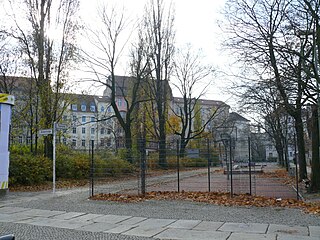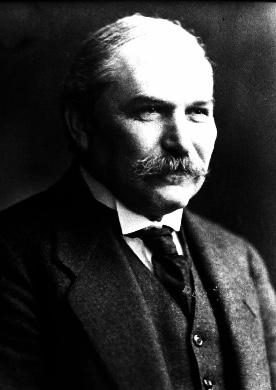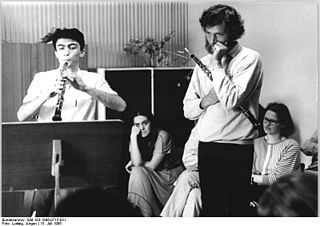Related Research Articles

Vittorio Magnago Lampugnani is an architect, architectural theorist and architectural historian as well as a professor emeritus for the History of Urban Design at the Swiss Federal Institute of Technology Zurich. He practices and promotes a formally disciplined, timelessly classic, and aesthetically sustainable form of architecture, one without modernist or postmodernist extravagances. As an author and editor of several acclaimed works of architectural history and theory, his ideas are widely cited.

John II, Margrave of Brandenburg-Stendal was co-ruler of Brandenburg with his brother Otto "with the arrow" from 1266 until his death. He also used the title Lord of Krossen, after a town in the Neumark.

Góra Świętej Anny or St. Anne Mountain is an inselberg in Upper Silesia, Poland, next to the community of the same name. It is the location of the Franciscan monastery with the miraculous statue of St. Anne and the imposing calvary, which is an important destination for Roman Catholic pilgrimage. It has been a strategic location important to both German and Polish nationalists, and in 1921 it was the site of the Battle of Annaberg, commemorated in the Third Reich by the construction of a Thingstätte (Amphitheatre) and a mausoleum. The theatre remains, but the Nazi mausoleum was destroyed and replaced with a monument to those who took part in the Third Silesian Uprising.

Eleanor Marie of Anhalt-Bernburg was a princess of Anhalt-Bernburg by birth and by marriage Duchess of Mecklenburg-Güstrow.

The Ackerstraße is a street in Berlin which runs northwest from near the Liesenstraße – Scheringstraße traffic circle in Gesundbrunnen to Invalidenstraße, where it turns south, terminating at the Linienstraße in Mitte.

Aleida Assmann is a German professor of English and Literary Studies, who studied Egyptology and whose work has focused on cultural anthropology and Cultural and Communicative Memory.

Carl Moritz was a German architect and real-estate entrepreneur. Based in Cologne, he built the Cologne opera house of 1902, and various banks, theatres and churches in Germany.

Juno and Argus is a 1610 painting by Peter Paul Rubens, depicting Juno and Argus. It is now in the Wallraf-Richartz Museum in Cologne.

Eberhard H. Gothein was a German economist and historian. Gothein was a professor at University of Karlsruhe (1885), University of Bonn (1890), and Heidelberg University (1904). He was a representative of the liberal-positivist opposition against the Prussian historical school of Treitschke and Sybel, which was prevalent in Germany. Gothein was the author of valuable works on cultural and economic history, primarily of the 15th to 17th centuries. Furthermore, he was one of the founding fathers of the University of Mannheim's predecessor, the Handelshochschule Mannheim.
Eberhard Otto was a German Egyptologist.

Vincenz Statz was a Neo-Gothic German architect, mainly active in the Rhineland.
Wilhelm Franz Josef Kosch was an Austrian historian of literature and theatre and lexicographer. The lexicon that he conceived and later revised several times, the Deutsches Literatur-Lexikon is a references in the field of German literature.

Burkhard Glaetzner is a German oboe virtuoso und conductor. He is one of the leading oboe players in Germany.

The Leibniz Institute for the History and Culture of Eastern Europe (GWZO) (German: Leibniz-Institut für Geschichte und Kultur des östlichen Europa), headquartered in Leipzig, is an interdisciplinary, internationally-oriented research institute of Eastern and Central Europe. Its main focus lies on the scientific study of the history and culture of the region bounded by the Baltic Sea, Black Sea, and Adriatic Sea from the Early Middle Ages to the present in a comparative perspective. The institute aims at contributing to a deeper understanding of the current political, economic and social developments in the countries, societies and cultures of Eastern Europe, especially the countries of East Central Europe. It is a member of the Leibniz Association.

Wilibald Nagel (also Willibald Nagel, was a German musicologist and music critic.
Heinz Stübig was a German pedagogue.
Walter August Wilhelm Schulz was a German cellist, viol player and college teacher. From 1945 to 1948 he was director of the Hochschule für Musik Franz Liszt, Weimar.
Felix Rudolf Skoda was a German architect and academic teacher. He was chief architect for the Neue Gewandhaus in Leipzig.
Matthias Untermann is a German art historian and medieval archaeologist.

Stefan Polónyi was a Hungarian-born German civil engineer.
References
- ↑ Dr. Arnold Bartetzky, freier Journalist und Kunsthistoriker auf www.dnk.de
- ↑ Arnold Bartetzky on www.leibniz-gwzo.de
- ↑ Die Baumeister der "deutschen Renaissance": ein Mythos der Kunstgeschichte? on WorldCat
- ↑ Neue Staaten – neue Bilder?: visuelle Kultur im Dienst staatlicher Selbstdarstellung in Zentral- und Osteuropa seit 1918, Visuelle Geschichtskultur on WorldCat
- ↑ Imaginationen des Urbanen: Konzeption, Reflexion und Fiktion von Stadt in Mittel- und Osteuropa on WorldCat
- ↑ Nation – Staat – Stadt: Architektur, Denkmalpflege und Geschichtskultur vom 19. bis zum 21. Jahrhundert, Visuelle Geschichtskultur on worldCat
- ↑ Geschichte im Rundumblick: Panoramabilder im östlichen Europa, Visuelle Geschichtskultur on WorldCat
- ↑ Die gerettete Stadt: Architektur und Stadtentwicklung in Leipzig seit 1989, Erfolge, Risiken, Verluste. on WorldCat